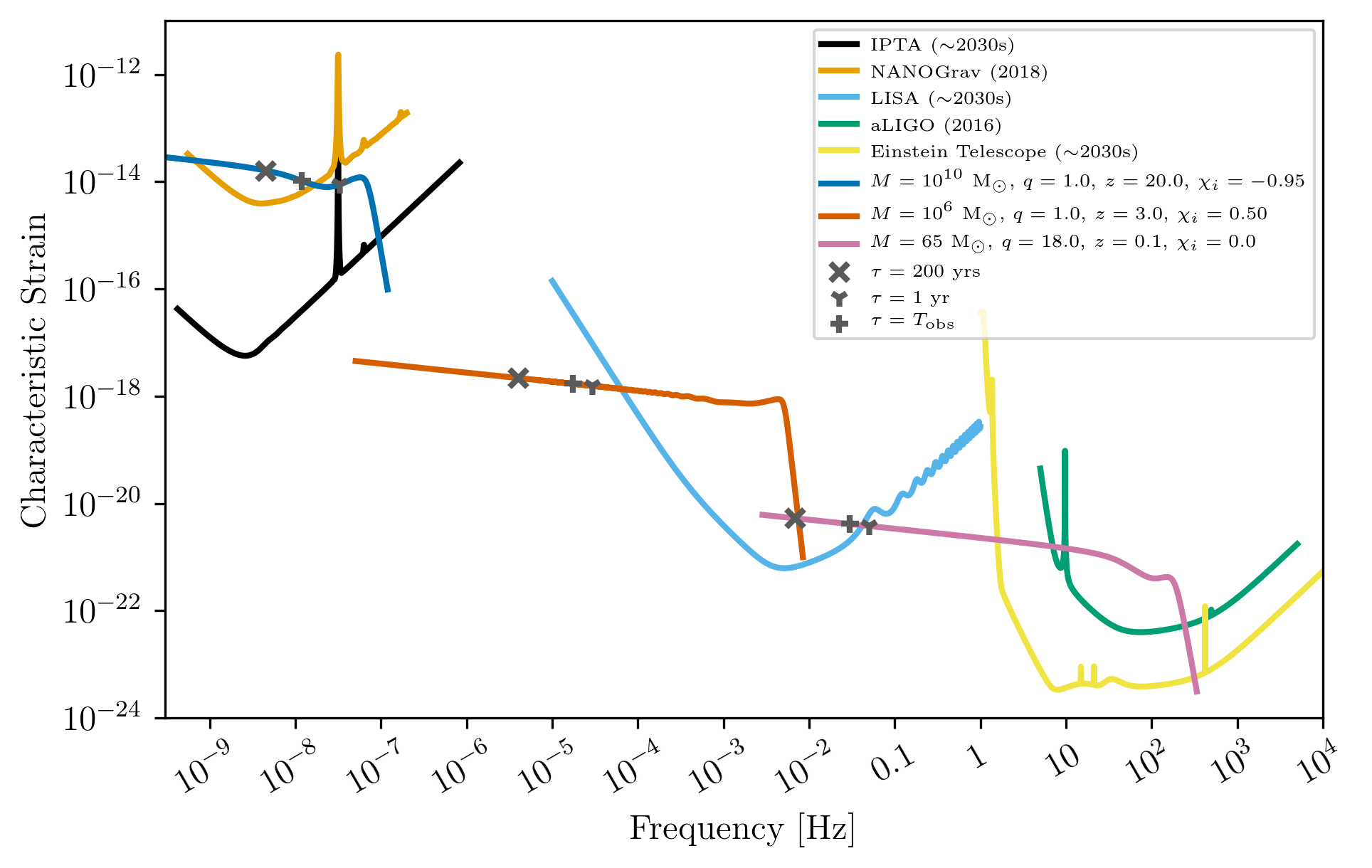Note
This tutorial was generated from a Jupyter notebook that can be downloaded here.
Using gwent to Generate Characteristic Strain Curves¶
Here we show examples of using the different classes in gwent for
various detectors, both loading in from a file and generating with
gwent, and binary black holes, both in the frequency and time
domain.
First, we load important packages
import numpy as np
import matplotlib as mpl
import matplotlib.pyplot as plt
from cycler import cycler
from scipy.constants import golden_ratio
import astropy.constants as const
import astropy.units as u
import gwent
import gwent.detector as detector
import gwent.binary as binary
#Turn off warnings for tutorial
import warnings
warnings.filterwarnings('ignore')
Setting matplotlib and plotting preferences
def get_fig_size(width=7,scale=1.0):
#width = 3.36 # 242 pt
base_size = np.array([1, 1/scale/golden_ratio])
fig_size = width * base_size
return(fig_size)
mpl.rcParams['figure.dpi'] = 300
mpl.rcParams['figure.figsize'] = get_fig_size()
mpl.rcParams['text.usetex'] = True
mpl.rc('font',**{'family':'serif','serif':['Times New Roman']})
mpl.rcParams['lines.linewidth'] = 2
mpl.rcParams['axes.labelsize'] = 12
mpl.rcParams['xtick.labelsize'] = 12
mpl.rcParams['ytick.labelsize'] = 12
mpl.rcParams['legend.fontsize'] = 10
color_cycle_wong = ['#000000','#E69F00','#56B4E9','#009E73','#F0E442','#0072B2','#D55E00','#CC79A7','#5a5a5a']
mpl.rcParams['axes.prop_cycle'] = cycler(color=color_cycle_wong)
We need to get the file directories to load in the instrument files.
load_directory = gwent.__path__[0] + '/LoadFiles'
Initialize different instruments¶
If loading a detector, the file should be frequency in the first column and either strain, effective strain noise spectral density, or amplitude spectral density in the second column.
For generating a detector, one must assign a value to each of the different instrument parameters (see the section on Declaring x and y variables and Sample Rates).
Load ground instruments from files¶
aLIGO¶
Ground_T_obs = 4*u.yr
#aLIGO
aLIGO_filedirectory = load_directory + '/InstrumentFiles/aLIGO/'
aLIGO_1_filename = 'aLIGODesign.txt'
aLIGO_2_filename = 'ZERO_DET_high_P.txt'
aLIGO_1_filelocation = aLIGO_filedirectory + aLIGO_1_filename
aLIGO_2_filelocation = aLIGO_filedirectory + aLIGO_2_filename
aLIGO_1 = detector.GroundBased('aLIGO 1',Ground_T_obs,load_location=aLIGO_1_filelocation,I_type='A')
aLIGO_2 = detector.GroundBased('aLIGO 2',Ground_T_obs,load_location=aLIGO_2_filelocation,I_type='A')
Einstein Telescope¶
#Einstein Telescope
ET_filedirectory = load_directory + '/InstrumentFiles/EinsteinTelescope/'
ET_B_filename = 'ET_B_data.txt'
ET_C_filename = 'ET_C_data.txt'
ET_D_filename = 'ET_D_data.txt'
ET_B_filelocation = ET_filedirectory + ET_B_filename
ET_C_filelocation = ET_filedirectory + ET_C_filename
ET_D_filelocation = ET_filedirectory + ET_D_filename
ET_B = detector.GroundBased('ET',Ground_T_obs,load_location=ET_B_filelocation,I_type='A')
ET_C = detector.GroundBased('ET',Ground_T_obs,load_location=ET_C_filelocation,I_type='A')
ET_D = detector.GroundBased('ET',Ground_T_obs,load_location=ET_D_filelocation,I_type='A')
Plots of Ground Detectors¶
fig = plt.figure()
plt.loglog(ET_B.fT,ET_B.h_n_f,label='Hild et al., (2008) ET Design B')
plt.loglog(ET_C.fT,ET_C.h_n_f,label='Einstein Telescope Design C')
plt.loglog(ET_D.fT,ET_D.h_n_f,label='Hild et al., (2011) ET Design D')
plt.loglog(aLIGO_1.fT,aLIGO_1.h_n_f,label='Advanced LIGO')
plt.loglog(aLIGO_2.fT,aLIGO_2.h_n_f,label='Advanced LIGO 2')
plt.xlabel(r'Frequency [Hz]')
plt.ylabel(r'Characteristic Strain')
plt.tick_params(axis = 'both',which = 'major')
plt.legend()
plt.show()

Load LISA Instruments from File¶
LISA Example 1¶
Modelled off of the Science Requirements document from https://lisa.nasa.gov/documentsReference.html.
SpaceBased_T_obs = 4*u.yr
LISA_Other_filedirectory = load_directory + '/InstrumentFiles/LISA_Other/'
LISA_ex1_filename = 'LISA_Allocation_S_h_tot.txt'
LISA_ex1_filelocation = LISA_Other_filedirectory + LISA_ex1_filename
#`I_type` should be Effective Noise Spectral Density
LISA_ex1 = detector.SpaceBased('LISA Example 1',SpaceBased_T_obs,load_location=LISA_ex1_filelocation,I_type='E')
LISA Example 2¶
Modelled off of Robson,Cornish,and Liu 2018, LISA (https://arxiv.org/abs/1803.01944).
LISA_ex2_filedirectory = load_directory + '/InstrumentFiles/LISA_Other/'
LISA_ex2_filename = 'LISA_sensitivity.txt'
LISA_ex2_filelocation = LISA_ex2_filedirectory + LISA_ex2_filename
#`I_type` should be Effective Noise Spectral Density
LISA_ex2 = detector.SpaceBased('LISA Example 2',SpaceBased_T_obs,load_location=LISA_ex2_filelocation,I_type='E')
LISA Example 3¶
Generated by http://www.srl.caltech.edu/~shane/sensitivity/
LISA_ex3_filename = 'scg_6981.dat'
LISA_ex3_filelocation = LISA_Other_filedirectory + LISA_ex3_filename
#`I_type` should be Amplitude Spectral Density
LISA_ex3 = detector.SpaceBased('LISA Example 3',SpaceBased_T_obs,load_location=LISA_ex3_filelocation,I_type='A')
Plots of loaded LISA examples.¶
fig = plt.figure()
plt.loglog(LISA_ex1.fT,LISA_ex1.h_n_f,label=LISA_ex1.name)
plt.loglog(LISA_ex2.fT,LISA_ex2.h_n_f,label=LISA_ex2.name)
plt.loglog(LISA_ex3.fT,LISA_ex3.h_n_f,label=LISA_ex3.name)
plt.xlabel(r'Frequency [Hz]')
plt.ylabel(r'Characteristic Strain')
plt.tick_params(axis = 'both',which = 'major')
plt.legend()
plt.show()
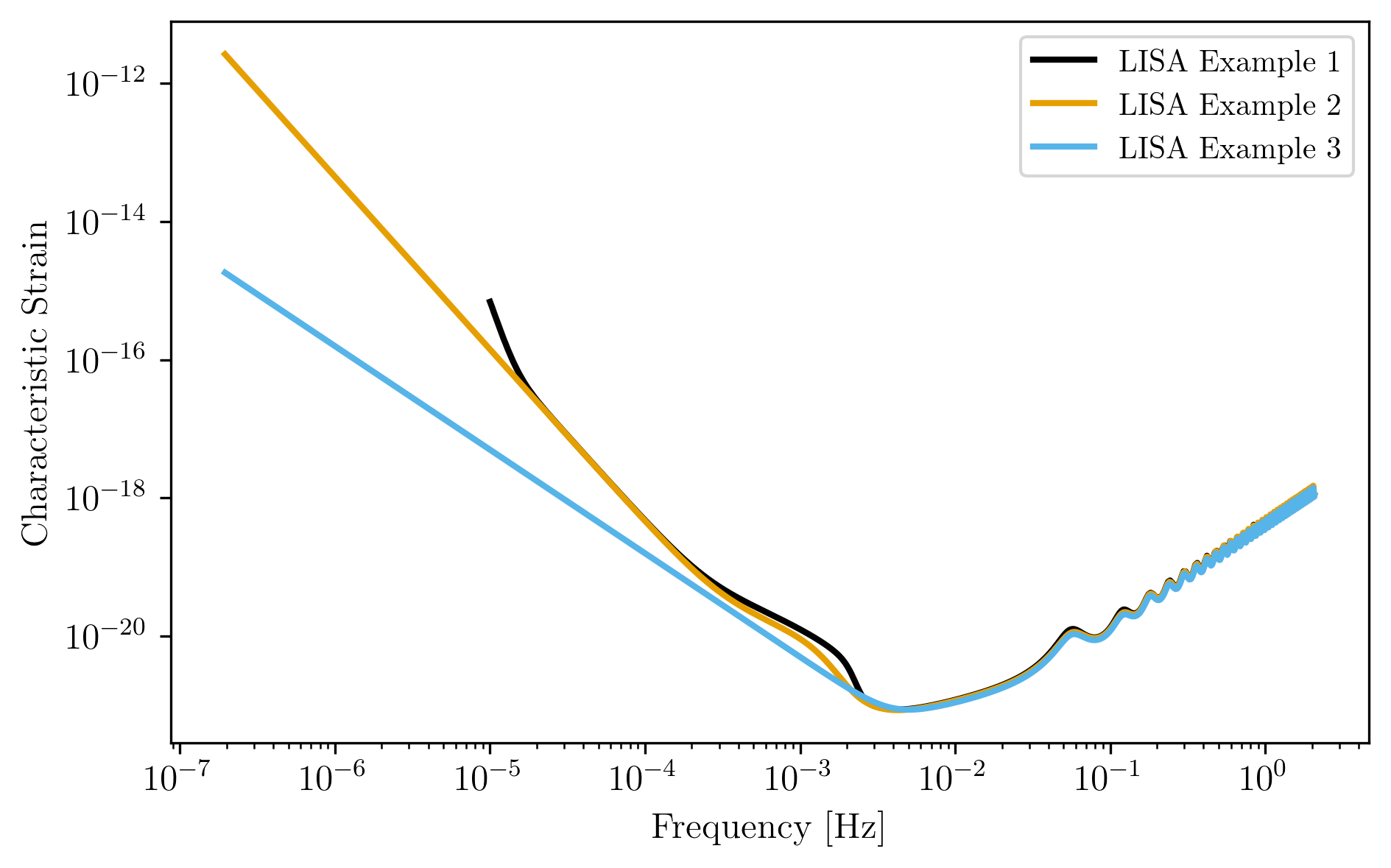
Loading PTA Detection Curves and Upper Limits¶
Simulated NANOGrav Continuous Wave Detection Sensitivity¶
Samples from Mingarelli, et al. 2017 (https://arxiv.org/abs/1708.03491) of the Simulated NANOGrav Continuous Wave Detection Sensitivity.
NANOGrav_filedirectory = load_directory + '/InstrumentFiles/NANOGrav/StrainFiles/'
#NANOGrav continuous wave sensitivity
NANOGrav_background = 4e-16 # Unsubtracted GWB amplitude: 0,4e-16
NANOGrav_dp = 0.95 #Detection Probablility: 0.95,0.5
NANOGrav_fap = 0.0001 #False Alarm Probability: 0.05,0.003,0.001,0.0001
NANOGrav_Tobs = 15 #Observation years: 15,20,25
NANOGrav_filename = 'cw_simulation_Ared_' + str(NANOGrav_background) + '_dp_' + str(NANOGrav_dp) \
+ '_fap_' + str(NANOGrav_fap) + '_T_' + str(NANOGrav_Tobs) + '.txt'
NANOGrav_filelocation = NANOGrav_filedirectory + NANOGrav_filename
NANOGrav_cw_GWB = detector.PTA('NANOGrav CW Detection w/ GWB',load_location=NANOGrav_filelocation,I_type='h')
#NANOGrav continuous wave sensitivity
NANOGrav_background_2 = 0 # Unsubtracted GWB amplitude: 0,4e-16
NANOGrav_dp_2 = 0.95 #Detection Probablility: 0.95,0.5
NANOGrav_fap_2 = 0.0001 #False Alarm Probability: 0.05,0.003,0.001,0.0001
NANOGrav_Tobs_2 = 15 #Observation years: 15,20,25
NANOGrav_filename_2 = 'cw_simulation_Ared_' + str(NANOGrav_background_2) + '_dp_' + str(NANOGrav_dp_2) \
+ '_fap_' + str(NANOGrav_fap_2) + '_T_' + str(NANOGrav_Tobs_2) + '.txt'
NANOGrav_filelocation_2 = NANOGrav_filedirectory + NANOGrav_filename_2
NANOGrav_cw_no_GWB = detector.PTA('NANOGrav CW Detection no GWB',load_location=NANOGrav_filelocation_2,I_type='h')
NANOGrav Continuous Wave 11yr Upper Limit¶
Sample from Aggarwal, et al. 2019 (https://arxiv.org/abs/1812.11585) of the NANOGrav 11yr continuous wave upper limit.
NANOGrav_cw_ul_file = NANOGrav_filedirectory + 'smoothed_11yr.txt'
NANOGrav_cw_ul = detector.PTA('NANOGrav CW Upper Limit',load_location=NANOGrav_cw_ul_file,I_type='h')
NANOGrav 11yr Characteristic Strain¶
Using real NANOGrav 11yr data put through hasasia. We need to
initialize and fill the values used in the plots (i.e.,
NANOGrav_11yr_hasasia.T_obs isn’t known until we set the values
since we loaded it from a file.
NANOGrav_11yr_hasasia_file = NANOGrav_filedirectory + 'NANOGrav_11yr_S_eff.txt'
NANOGrav_11yr_hasasia = detector.PTA('NANOGrav 11yr',load_location=NANOGrav_11yr_hasasia_file,I_type='E')
NANOGrav_11yr_hasasia.T_obs = 11.4*u.yr
Plots of the loaded PTAs¶
fig = plt.figure()
plt.loglog(NANOGrav_cw_GWB.fT,NANOGrav_cw_GWB.h_n_f,label = r'Mingarelli et al. (2017), CW Detection Probability w/GWB')
plt.loglog(NANOGrav_cw_no_GWB.fT,NANOGrav_cw_no_GWB.h_n_f, label =r'Mingarelli et al. (2017), CW Detection Probability w/o GWB')
plt.loglog(NANOGrav_cw_ul.fT,NANOGrav_cw_ul.h_n_f, label = r'Aggarwal et al. (2018), CW Upper Limit')
plt.loglog(NANOGrav_11yr_hasasia.fT,np.sqrt(NANOGrav_11yr_hasasia.S_n_f/np.max(np.unique(NANOGrav_11yr_hasasia.T_obs.to('s').value))),
label = r'NANOGrav: 11yr Data corresponding to a source strain with SNR of one')
plt.tick_params(axis = 'both',which = 'major')
plt.ylim([2e-15,6e-12])
plt.xlim([4e-10,4e-7])
plt.xlabel(r'Frequency [Hz]')
plt.ylabel('Strain')
plt.legend(loc='upper left',fontsize=8)
plt.show()
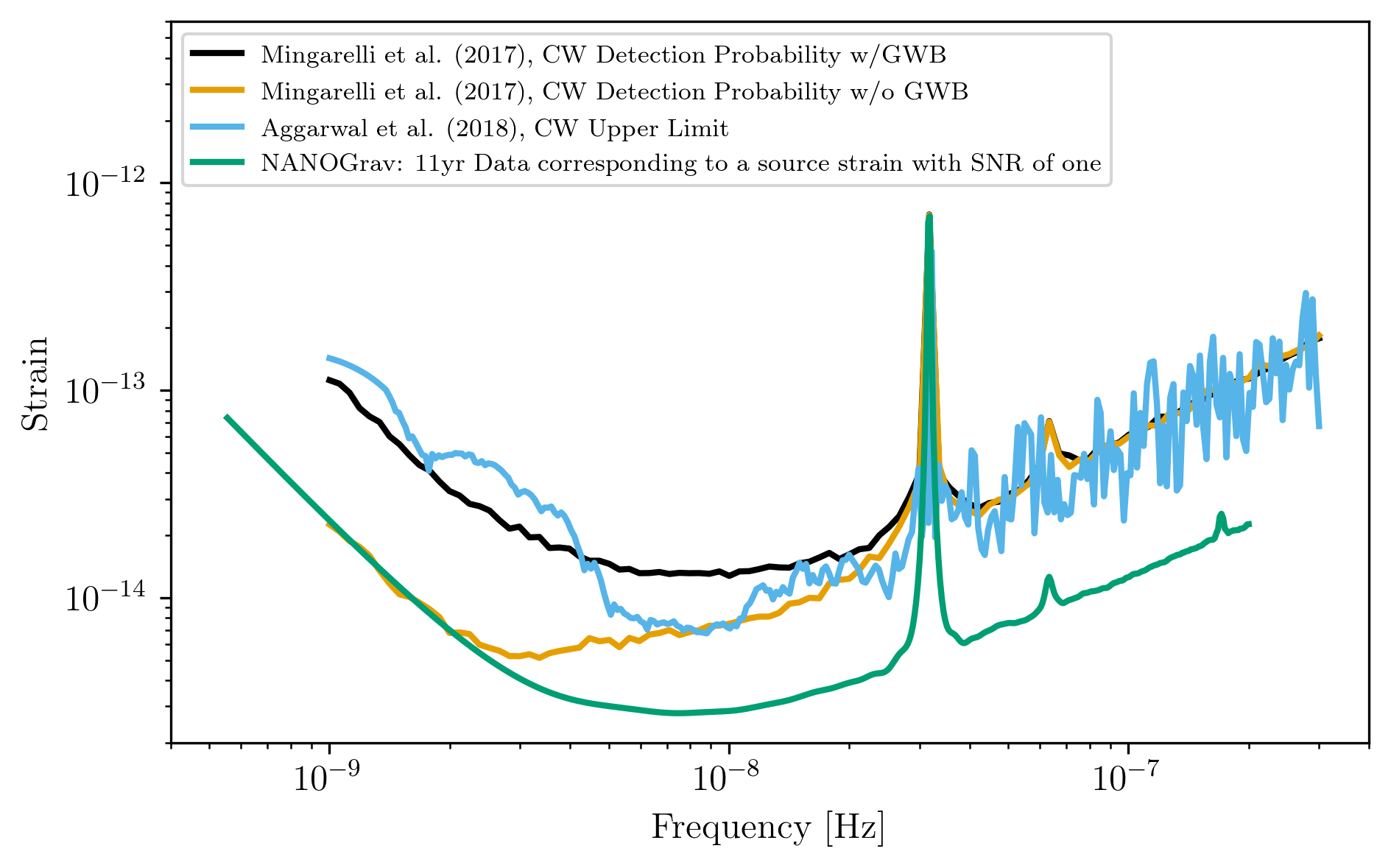
Generating PTAs with gwent¶
Generated using the code hasasia
(https://hasasia.readthedocs.io/en/latest/) via the methods of Hazboun,
Romano, and Smith, 2019 (https://arxiv.org/abs/1907.04341)
SKA-esque Detector¶
Fiducial parameter estimates from Sesana, Vecchio, and Colacino, 2008 (https://arxiv.org/abs/0804.4476) section 7.1.
sigma_SKA = 10*u.ns.to('s')*u.s #sigma_rms timing residuals in nanoseconds to seconds
T_SKA = 15*u.yr #Observing time in years
N_p_SKA = 20 #Number of pulsars
cadence_SKA = 1/(u.wk.to('yr')*u.yr) #Avg observation cadence of 1 every week in [number/yr]
SKA with White noise only
SKA_WN = detector.PTA('SKA, WN Only',N_p_SKA,T_obs=T_SKA,sigma=sigma_SKA,cadence=cadence_SKA)
SKA with White and Varied Red Noise
SKA_WN_RN = detector.PTA('SKA, WN and RN',N_p_SKA,T_obs=T_SKA,sigma=sigma_SKA,cadence=cadence_SKA,
rn_amp=[1e-16,1e-12],rn_alpha=[-1/2,1.25])
SKA with White Noise and a Stochastic Gravitational Wave Background
SKA_WN_GWB = detector.PTA('SKA, WN and GWB',N_p_SKA,T_obs=T_SKA,sigma=sigma_SKA,cadence=cadence_SKA,
sb_amp=4e-16,sb_alpha=-2/3)
SKA with Sampled Noise for each pulsar, no GWB
SKA_Sampled_Noise = detector.PTA('SKA, Sampled Noise',N_p_SKA,cadence=[cadence_SKA,cadence_SKA/4.],
sigma=[sigma_SKA,10*sigma_SKA],T_obs=T_SKA,use_11yr=True,use_rn=True)
Plots for Simulated SKA PTAs¶
fig = plt.figure()
plt.loglog(SKA_WN.fT,SKA_WN.h_n_f,label = SKA_WN.name)
plt.loglog(SKA_WN_GWB.fT,SKA_WN_GWB.h_n_f, linestyle=':',label = SKA_WN_GWB.name)
plt.loglog(SKA_WN_RN.fT,SKA_WN_RN.h_n_f, linestyle='-.',label = SKA_WN_RN.name)
plt.loglog(SKA_Sampled_Noise.fT,SKA_Sampled_Noise.h_n_f,linestyle='--',label=SKA_Sampled_Noise.name)
plt.tick_params(axis = 'both',which = 'major')
plt.ylim([1e-18,2e-11])
plt.xlim([3e-10,1e-6])
plt.xlabel('Frequency [Hz]')
plt.ylabel('Characteristic Strain')
plt.legend(loc='upper left')
plt.show()
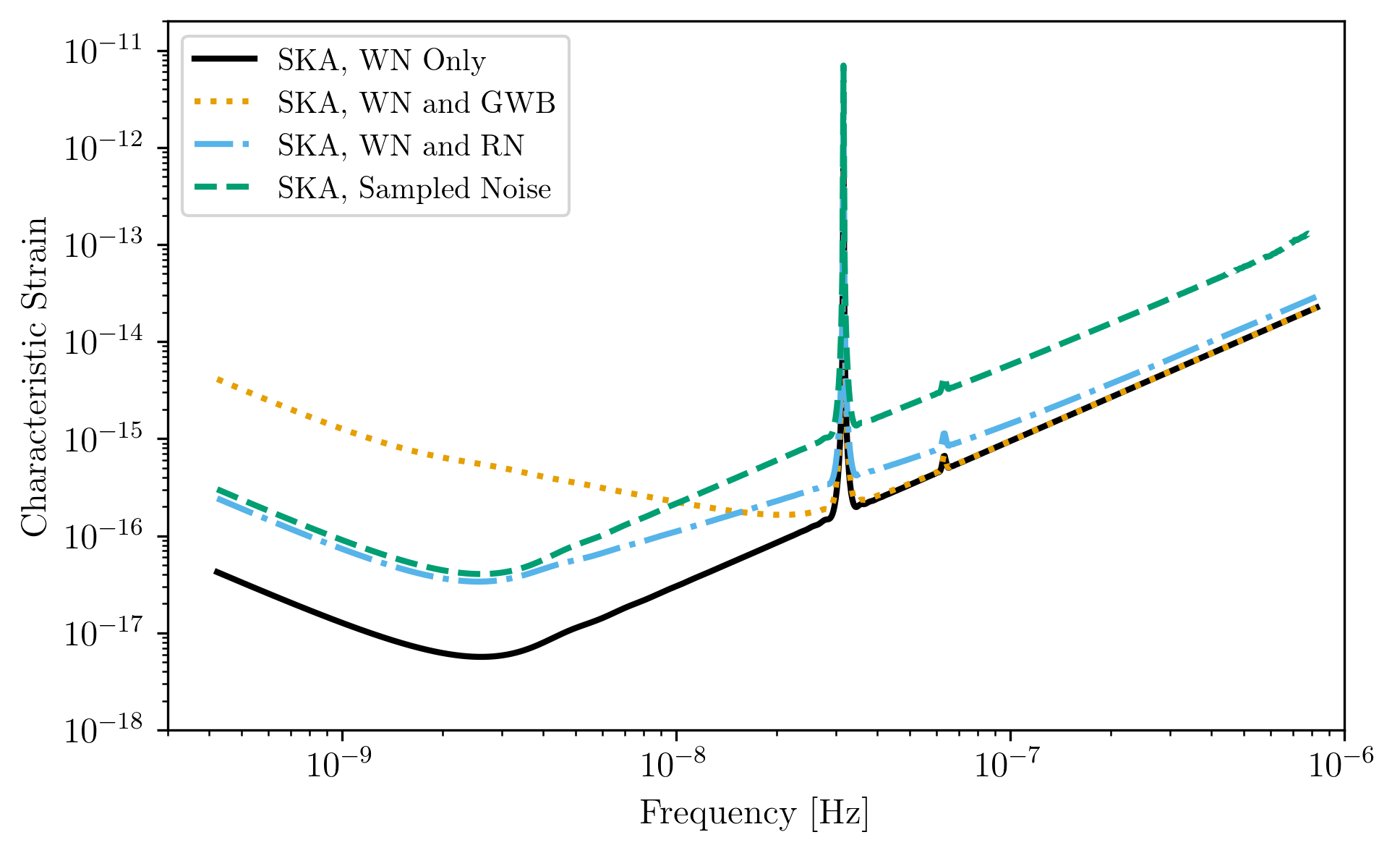
NANOGrav-esque Detector¶
Fiducial 11yr parameter estimates from Arzoumanian, et al., 2018 https://arxiv.org/abs/1801.01837
###############################################
#NANOGrav calculation using 11.5yr parameters https://arxiv.org/abs/1801.01837
sigma_nano = 100*u.ns.to('s')*u.s #rms timing residuals in nanoseconds to seconds
T_nano = 11.4*u.yr #Observing time in years
N_p_nano = 34 #Number of pulsars
cadence_nano = 1/(2*u.wk.to('yr')*u.yr) #Avg observation cadence of 1 every 2 weeks in number/year
NANOGrav with White Noise only
NANOGrav_WN = detector.PTA('NANOGrav, WN Only',N_p_nano,T_obs=T_nano,sigma=sigma_nano,cadence=cadence_nano)
NANOGrav with White and Varied Red Noise
NANOGrav_WN_RN = detector.PTA('NANOGrav, WN and RN',N_p_nano,T_obs=T_nano,sigma=sigma_nano,cadence=cadence_nano,
rn_amp=[1e-16,1e-12],rn_alpha=[-1/2,1.25])
NANOGrav with White Noise and a Stochastic Gravitational Wave Background
NANOGrav_WN_GWB = detector.PTA('NANOGrav, WN and GWB',N_p_nano,
T_obs=T_nano,sigma=sigma_nano,cadence=cadence_nano,sb_amp=4e-16)
NANOGrav with Sampled Noise for each pulsar, no GWB
NANOGrav_Sampled_Noise = detector.PTA('NANOGrav, Sampled Noise',N_p_nano,use_11yr=True,use_rn=True)
Plots for Simulated NANOGrav PTAs¶
fig = plt.figure()
plt.loglog(NANOGrav_WN.fT,NANOGrav_WN.h_n_f,
label=NANOGrav_WN.name)
plt.loglog(NANOGrav_WN_GWB.fT,NANOGrav_WN_GWB.h_n_f,
linestyle=':',label=NANOGrav_WN_GWB.name)
plt.loglog(NANOGrav_WN_RN.fT,NANOGrav_WN_RN.h_n_f,
linestyle='-.',label=NANOGrav_WN_RN.name)
plt.loglog(NANOGrav_Sampled_Noise.fT,NANOGrav_Sampled_Noise.h_n_f,
linestyle='--',label=NANOGrav_Sampled_Noise.name)
plt.loglog(NANOGrav_11yr_hasasia.fT,NANOGrav_11yr_hasasia.h_n_f,
label = r'NANOGrav: 11yr Data')
plt.tick_params(axis = 'both',which = 'major')
plt.ylim([3e-17,2e-11])
plt.xlim([3e-10,5e-7])
plt.xlabel('Frequency [Hz]')
plt.ylabel('Characteristic Strain')
plt.legend(loc='upper left')
plt.show()
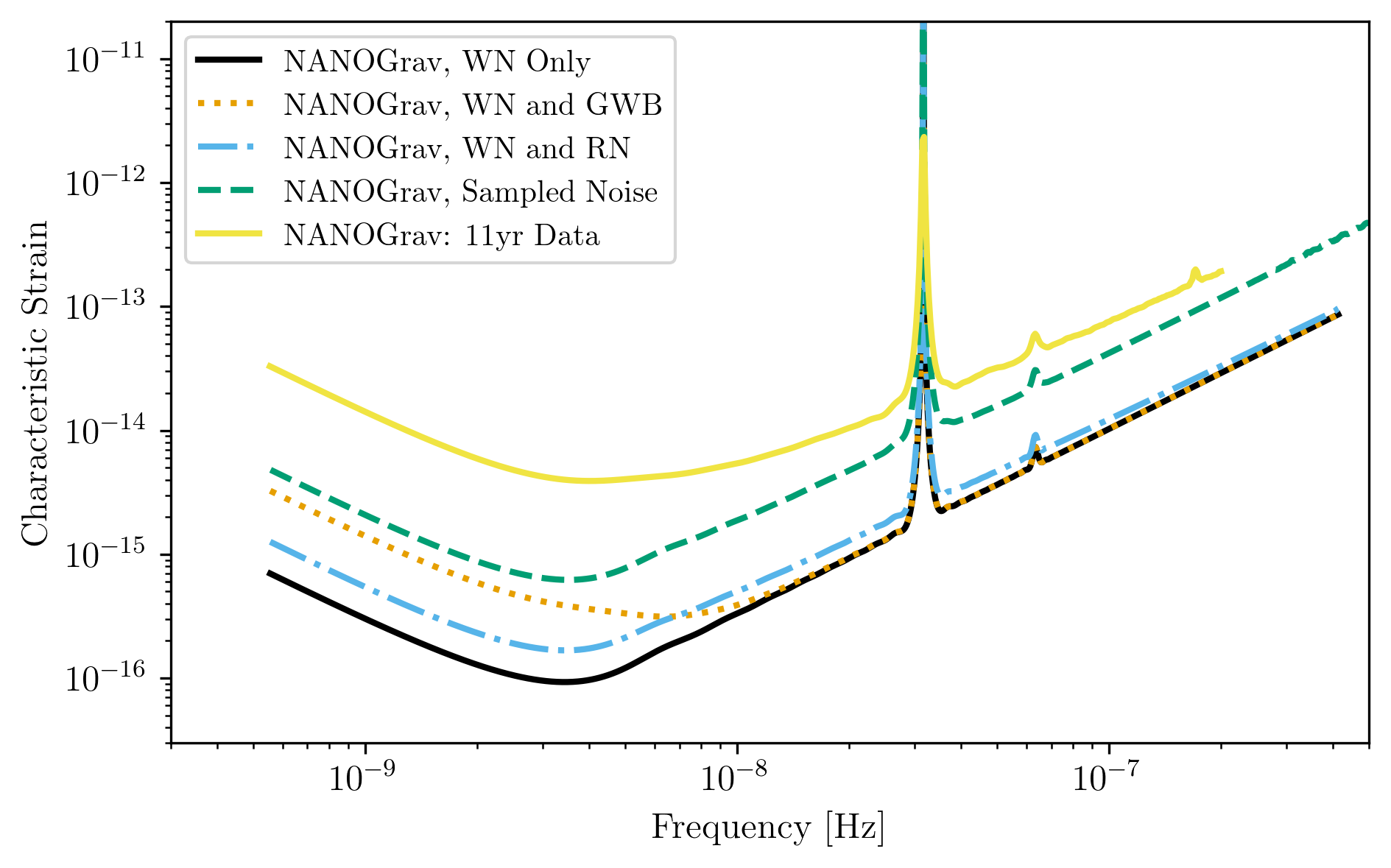
Generating LISA designs with gwent¶
First we set a fiducial armlength and observation time-length
L = 2.5*u.Gm #armlength in Gm
L = L.to('m')
LISA_T_obs = 4*u.yr
LISA Proposal 1¶
Values taken from the ESA L3 proposal, Amaro-Seaone, et al., 2017 (https://arxiv.org/abs/1702.00786)
f_acc_break_low = .4*u.mHz.to('Hz')*u.Hz
f_acc_break_high = 8.*u.mHz.to('Hz')*u.Hz
f_IMS_break = 2.*u.mHz.to('Hz')*u.Hz
A_acc = 3e-15*u.m/u.s/u.s
A_IMS = 10e-12*u.m
Background = False
LISA_prop1 = detector.SpaceBased('LISA',\
LISA_T_obs,L,A_acc,f_acc_break_low,f_acc_break_high,A_IMS,f_IMS_break,\
Background=Background)
LISA Proposal 1 with Galactic Binary Background¶
Values taken from the ESA L3 proposal, Amaro-Seaone, et al., 2017 (https://arxiv.org/abs/1702.00786)
f_acc_break_low = .4*u.mHz.to('Hz')*u.Hz
f_acc_break_high = 8.*u.mHz.to('Hz')*u.Hz
f_IMS_break = 2.*u.mHz.to('Hz')*u.Hz
A_acc = 3e-15*u.m/u.s/u.s
A_IMS = 10e-12*u.m
Background = True
LISA_prop1_w_background = detector.SpaceBased('LISA w/Background',\
LISA_T_obs,L,A_acc,f_acc_break_low,f_acc_break_high,A_IMS,f_IMS_break,\
Background=Background)
LISA Proposal 2¶
Values from Robson, Cornish, and Liu 2019 https://arxiv.org/abs/1803.01944 using the Transfer Function Approximation within. (Note the factor of 2 change from summing 2 independent low-frequency data channels assumed in the paper.)
f_acc_break_low = .4*u.mHz.to('Hz')*u.Hz
f_acc_break_high = 8.*u.mHz.to('Hz')*u.Hz
f_IMS_break = 2.*u.mHz.to('Hz')*u.Hz
A_acc = 3e-15*u.m/u.s/u.s
A_IMS = 1.5e-11*u.m
Background = False
LISA_prop2 = detector.SpaceBased('LISA Approximate',
LISA_T_obs,L,A_acc,f_acc_break_low,f_acc_break_high,A_IMS,f_IMS_break,
Background=Background,T_type='A')
Plots of Generated LISA Detectors¶
fig = plt.figure()
plt.loglog(LISA_prop1.fT,LISA_prop1.h_n_f,label=r'LISA: L3 Proposal, Amaro-Seoane et al., (2017)')
plt.loglog(LISA_prop1_w_background.fT,LISA_prop1_w_background.h_n_f,label=r'LISA: L3 Proposal + Background',
linestyle='--')
plt.loglog(LISA_prop2.fT,LISA_prop2.h_n_f,label=r'Robson et al., (2019)',zorder=-1)
plt.xlabel(r'Frequency [Hz]')
plt.ylabel(r'Characteristic Strain')
plt.tick_params(axis = 'both',which = 'major')
plt.legend()
plt.show()
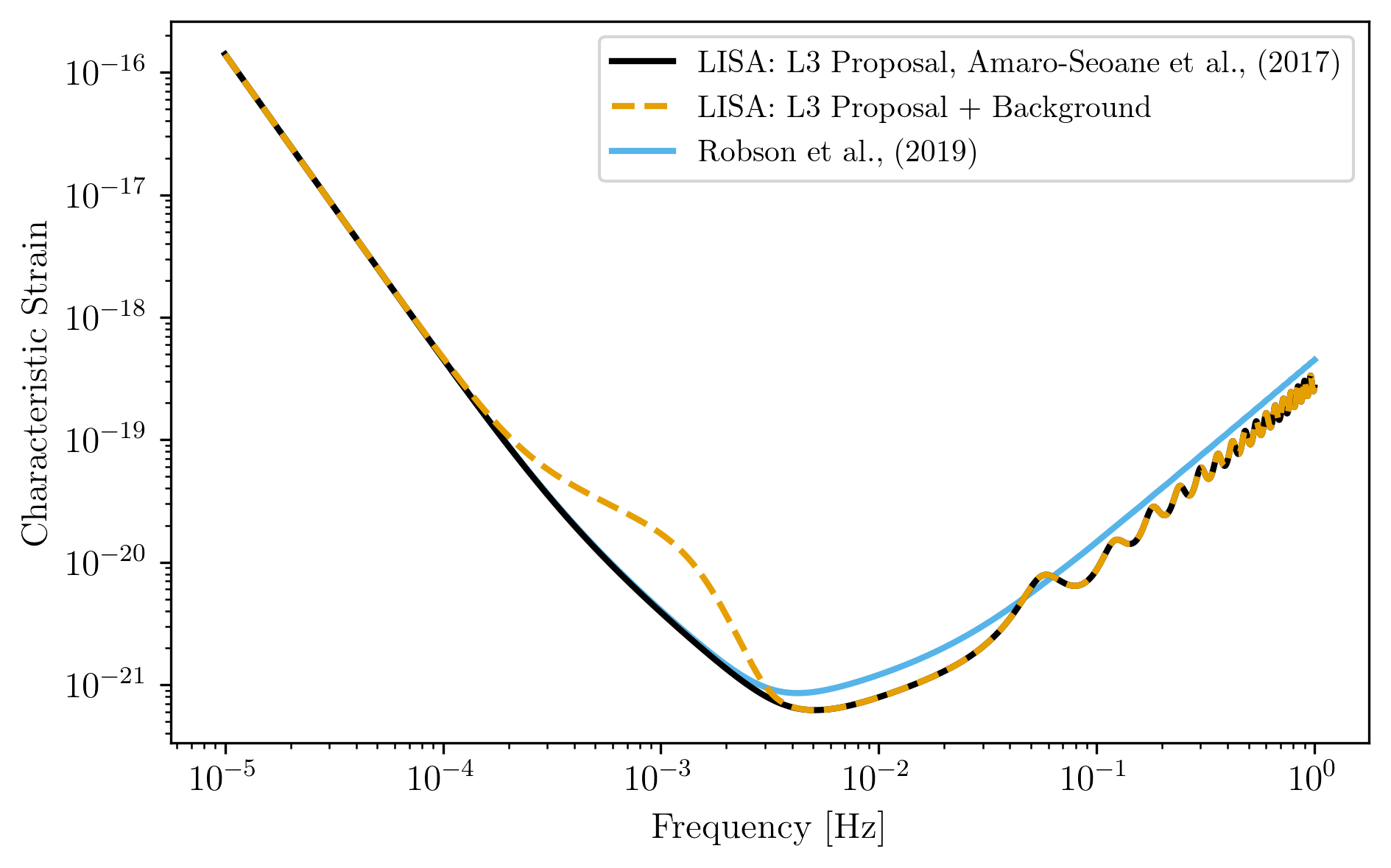
Generating Ground Based Detector Designs with gwent¶
First we set a fiducial observation time-length
Ground_T_obs = 4*u.yr
aLIGO¶
aLIGO_prop1 = detector.GroundBased('aLIGO',Ground_T_obs,f_low=min(aLIGO_1.fT),f_high=max(aLIGO_1.fT))
If one wanted to change the parameters from the fiducial values, you could set up a new noise dictionary, then initialize that instument with the new values. It also works for updating the current instrument values.
noise_dict = {'Infrastructure':
{'Length':2500},
'Materials':
{'Substrate':{'Temp':500}}}
aLIGO_prop2 = detector.GroundBased('aLIGO prop 2',Ground_T_obs,noise_dict=noise_dict)
A+¶
Aplus_prop1 = detector.GroundBased('Aplus',Ground_T_obs,f_low=min(aLIGO_1.fT),f_high=max(aLIGO_1.fT))
If you want to see what the current instrument parameters are, and what
you can vary, you can use the instrument.Get_Noise_Dict(). To access
each parameter, you must make a noise dictionary like above that matches
the depth of the parameter you wish to change.
Aplus_prop1.Get_Noise_Dict()
Infrastructure Parameters:
Length : 3995
Temp : 290
ResidualGas Subparameters:
pressure : 4e-07
mass : 3.35e-27
polarizability : 7.8e-31
TCS Parameters:
s_cc : 7.024
s_cs : 7.321
s_ss : 7.631
SRCloss : 0.0
Seismic Parameters:
Site : LHO
KneeFrequency : 10
LowFrequencyLevel : 1e-09
Gamma : 0.8
Rho : 1800.0
Beta : 0.8
Omicron : 1
TestMassHeight : 1.5
RayleighWaveSpeed : 250
Suspension Parameters:
Type : Quad
FiberType : Tapered
BreakStress : 750000000.0
Temp : 290
Silica Subparameters:
Rho : 2200.0
C : 772
K : 1.38
Alpha : 3.9e-07
dlnEdT : 0.000152
Phi : 4.1e-10
Y : 72000000000.0
Dissdepth : 0.015
C70Steel Subparameters:
Rho : 7800
C : 486
K : 49
Alpha : 1.2e-05
dlnEdT : -0.00025
Phi : 0.0002
Y : 212000000000.0
MaragingSteel Subparameters:
Rho : 7800
C : 460
K : 20
Alpha : 1.1e-05
dlnEdT : 0
Phi : 0.0001
Y : 187000000000.0
Silicon Subparameters:
Rho : 2329
C : 300
K : 700
Alpha : 1e-10
dlnEdT : -2e-05
Phi : 2e-09
Y : 155800000000.0
Dissdepth : 0.0015
Stage : array of shape 4
Ribbon Subparameters:
Thickness : 0.000115
Width : 0.00115
Fiber Subparameters:
Radius : 0.000205
EndRadius : 0.0004
EndLength : 0.045
VHCoupling Subparameters:
theta : 0.0006263620827519167
hForce : array of shape (1000,)
vForce : array of shape (1000,)
hForce_singlylossy : array of shape (4, 1000)
vForce_singlylossy : array of shape (4, 1000)
hTable : array of shape (1000,)
vTable : array of shape (1000,)
Materials Parameters:
MassRadius : 0.17
MassThickness : 0.2
Coating Subparameters:
Yhighn : 124000000000.0
Sigmahighn : 0.28
CVhighn : 2100000.0
Alphahighn : 3.6e-06
Betahighn : 1.4e-05
ThermalDiffusivityhighn : 33
Indexhighn : 2.06539
Phihighn : 9e-05
Phihighn_slope : 0.1
Ylown : 72000000000.0
Sigmalown : 0.17
CVlown : 1641200.0
Alphalown : 5.1e-07
Betalown : 8e-06
ThermalDiffusivitylown : 1.38
Indexlown : 1.45
Philown : 1.25e-05
Philown_slope : 0.4
Substrate Subparameters:
Temp : 295
c2 : 7.6e-12
MechanicalLossExponent : 0.77
Alphas : 5.2e-12
MirrorY : 72700000000.0
MirrorSigma : 0.167
MassDensity : 2200.0
MassAlpha : 3.9e-07
MassCM : 739
MassKappa : 1.38
RefractiveIndex : 1.45
MirrorVolume : 0.01815840553774901
MirrorMass : 39.948492183047826
Laser Parameters:
Wavelength : 1.064e-06
Power : 125
Optics Parameters:
Type : SignalRecycled
PhotoDetectorEfficiency : 0.9
Loss : 3.75e-05
BSLoss : 0.0005
coupling : 1.0
SubstrateAbsorption : 5e-05
pcrit : 10
Quadrature Subparameters:
dc : 1.5707963
ITM Subparameters:
Transmittance : 0.014
CoatingThicknessLown : 0.308
CoatingThicknessCap : 0.5
CoatingAbsorption : 5e-07
Thickness : 0.2
CoatLayerOpticalThickness : array of shape (16,)
BeamRadius : 0.05549089680470938
ETM Subparameters:
Transmittance : 5e-06
CoatingThicknessLown : 0.27
CoatingThicknessCap : 0.5
CoatLayerOpticalThickness : array of shape (38,)
BeamRadius : 0.06203311014519086
PRM Subparameters:
Transmittance : 0.03
SRM Subparameters:
Transmittance : 0.325
CavityLength : 55
Tunephase : 0.0
Curvature Subparameters:
ITM : 1970
ETM : 2192
Squeezer Parameters:
Type : Freq Dependent
AmplitudedB : 12
InjectionLoss : 0.05
SQZAngle : 0
LOAngleRMS : 0.03
FilterCavity Subparameters:
L : 300
Te : 1e-06
Lrt : 6e-05
Rot : 0
fdetune : -45.78
Ti : 0.0012
gwinc Parameters:
PRfixed : True
pbs : 5351.309810308315
parm : 750599.8555500002
finesse : 446.4074818600061
prfactor : 42.81047848246652
gITM : -1.0279187817258881
gETM : -0.822536496350365
BeamWaist : 0.011750961823848846
BeamRayleighRange : 407.7134846079674
BeamWaistToITM : 1881.657523510972
BeamWaistToETM : 2113.3424764890283
dhdl_sqr : array of shape (1000,)
sinc_sqr : array of shape (1000,)
Number of Variables: 150
Voyager¶
Voyager_prop1 = detector.GroundBased('Voyager',Ground_T_obs)
Cosmic Explorer¶
CE1_prop1 = detector.GroundBased('CE1',Ground_T_obs)
Plots of Generated Ground Based Detectors¶
fig = plt.figure()
plt.loglog(aLIGO_prop1.fT,aLIGO_prop1.h_n_f,label='Advanced LIGO Prop 1')
plt.loglog(aLIGO_prop2.fT,aLIGO_prop2.h_n_f,label='Advanced LIGO Prop 2')
plt.loglog(ET_D.fT,ET_D.h_n_f,label='Hild et al., (2011) ET Design D')
plt.loglog(Aplus_prop1.fT,Aplus_prop1.h_n_f,label='LIGO A+',
linestyle=':')
plt.loglog(Voyager_prop1.fT,Voyager_prop1.h_n_f,label='Voyager',
linestyle='--')
plt.loglog(CE1_prop1.fT,CE1_prop1.h_n_f,label='Cosmic Explorer Proposal 1')
plt.xlabel(r'Frequency [Hz]')
plt.ylabel(r'Characteristic Strain')
plt.tick_params(axis = 'both',which = 'major')
plt.legend()
plt.show()
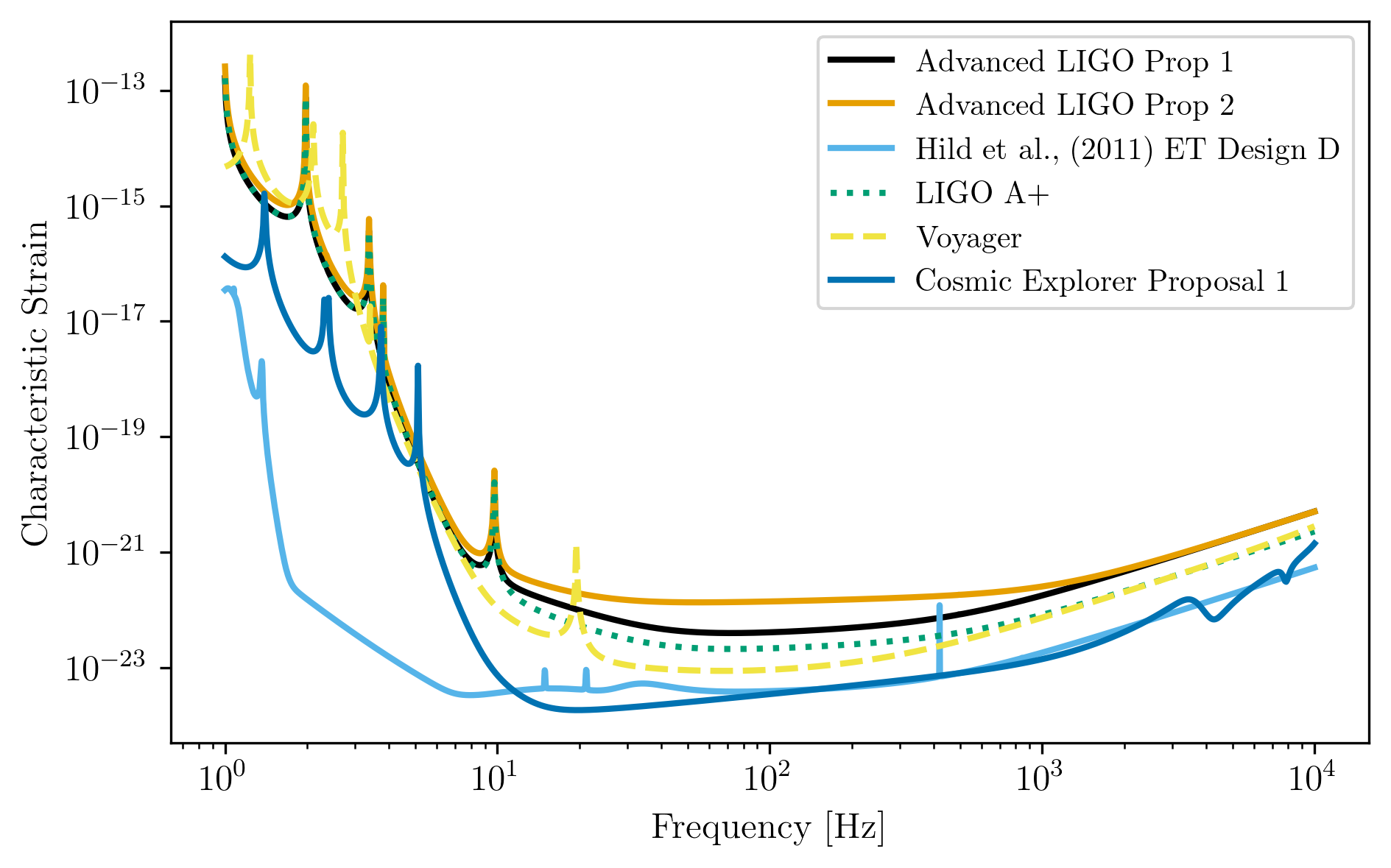
Generating Binary Black Holes with gwent in the Frequency Domain¶
We start with BBH parameters that exemplify the range of IMRPhenomD’s waveforms from Khan, et al. 2016 https://arxiv.org/abs/1508.07253 and Husa, et al. 2016 https://arxiv.org/abs/1508.07250
For more information see the tutorial on source strains.
M = [1e6,65.0,1e10]
q = [1.0,18.0,1.0]
x1 = [0.5,0.0,-0.95]
x2 = [0.2,0.0,-0.95]
z = [3.0,0.093,20.0]
Uses the first parameter values and the LISA_prop1 detector model
for the observation time with the precessing phenomenological
lalsuite waveform IMRPhenomPv3.
lalsuite_kwargs = {"S1x": 0.5, "S1y": 0., "S1z": x1[0],
"S2x": -0.2, "S2y": 0.5, "S2z": x2[0],
"inclination":np.pi/2}
source_1 = binary.BBHFrequencyDomain(M[0],q[0],z[0],instrument=LISA_prop1,
approximant='IMRPhenomPv3',lalsuite_kwargs=lalsuite_kwargs)
Uses the first parameter values and the aLIGO detector model for the
observation time.
source_2 = binary.BBHFrequencyDomain(M[1],q[1],z[1],x1[1],x2[1],instrument=aLIGO_1)
Uses the first parameter values and the SKA_WN detector model for
the observation time.
source_3 = binary.BBHFrequencyDomain(M[2],q[2],z[2],x1[2],x2[2],instrument=SKA_WN)
To display the time it takes for each source to evolve, we find several
markers in time: 200 years prior to merger, T_obs until merger, and
one year until merger. In each call, we assume the time to merger is in
the observer frame (i.e., in_frame = 'observer')
t_year = u.yr.to('s')*u.s
t_200_year = 200.*t_year
#Source 1
source_1_t_200_year_f = binary.Get_Source_Freq(source_1,t_200_year,
in_frame='observer',out_frame='observer')
idx1 = np.abs(source_1.f-source_1_t_200_year_f).argmin()
source_1_t_200_year_h = binary.Get_Char_Strain(source_1)[idx1]
source_1_t_year_f = binary.Get_Source_Freq(source_1,t_year,
in_frame='observer',out_frame='observer')
idx2 = np.abs(source_1.f-source_1_t_year_f).argmin()
source_1_t_year_h = binary.Get_Char_Strain(source_1)[idx2]
source_1_t_T_obs_f = binary.Get_Source_Freq(source_1,source_1.instrument.T_obs,
in_frame='observer',out_frame='observer')
idx3 = np.abs(source_1.f-source_1_t_T_obs_f).argmin()
source_1_t_T_obs_h = binary.Get_Char_Strain(source_1)[idx3]
#Source 2
source_2_t_200_year_f = binary.Get_Source_Freq(source_2,t_200_year,
in_frame='observer',out_frame='observer')
idx4 = np.abs(source_2.f-source_2_t_200_year_f).argmin()
source_2_t_200_year_h = binary.Get_Char_Strain(source_2)[idx4]
source_2_t_year_f = binary.Get_Source_Freq(source_2,t_year,
in_frame='observer',out_frame='observer')
idx5 = np.abs(source_2.f-source_2_t_year_f).argmin()
source_2_t_year_h = binary.Get_Char_Strain(source_2)[idx5]
source_2_t_T_obs_f = binary.Get_Source_Freq(source_2,source_2.instrument.T_obs,
in_frame='observer',out_frame='observer')
idx6 = np.abs(source_2.f-source_2_t_T_obs_f).argmin()
source_2_t_T_obs_h = binary.Get_Char_Strain(source_2)[idx6]
#Source 3
source_3_t_200_year_f = binary.Get_Source_Freq(source_3,t_200_year,
in_frame='observer',out_frame='observer')
idx7 = np.abs(source_3.f-source_3_t_200_year_f).argmin()
source_3_t_200_year_h = binary.Get_Char_Strain(source_3)[idx7]
source_3_t_year_f = binary.Get_Source_Freq(source_3,t_year,
in_frame='observer',out_frame='observer')
idx8 = np.abs(source_3.f-source_3_t_year_f).argmin()
source_3_t_year_h = binary.Get_Char_Strain(source_3)[idx8]
source_3_t_T_obs_f = binary.Get_Source_Freq(source_3,np.unique(np.max(source_3.instrument.T_obs)),
in_frame='observer',out_frame='observer')
idx9 = np.abs(source_3.f-source_3_t_T_obs_f).argmin()
source_3_t_T_obs_h = binary.Get_Char_Strain(source_3)[idx9]
Plots of Entire GW Band¶
Displays only generated detectors: WN only PTAs, ESA L3 proposal LISA, aLIGO, and Einstein Telescope.
Displays three sources’ waveform along with their monochromatic strain
if they were observed by the initialized instrument at the detector’s
most sensitive frequency throughout its observing run (from left to
right: SKA_WN,LISA_prop1,ET).
fig,ax = plt.subplots()
zord = 10.
ax.loglog(SKA_WN.fT,SKA_WN.h_n_f,label = r'IPTA ($\sim$2030s)')
ax.loglog(NANOGrav_11yr_hasasia.fT,NANOGrav_11yr_hasasia.h_n_f,label = 'NANOGrav (2018)')
ax.loglog(LISA_prop1.fT,LISA_prop1.h_n_f,label = 'LISA ($\sim$2030s)')
ax.loglog(aLIGO_1.fT,aLIGO_1.h_n_f,label = 'aLIGO (2016)')
ax.loglog(ET_D.fT,ET_D.h_n_f,label = 'Einstein Telescope ($\sim$2030s)')
ax.loglog(source_3.f,binary.Get_Char_Strain(source_3),
label = r'$M = 10^{%.0f}$ $\mathrm{M}_{\odot}$, $q = %.1f$, $z = %.1f$, $\chi_{i} = %.2f$' %(np.log10(M[2]),q[2],z[2],x1[2]))
ax.loglog(source_1.f,binary.Get_Char_Strain(source_1),
label = r'$M = 10^{%.0f}$ $\mathrm{M}_{\odot}$, $q = %.1f$, $z = %.1f$, $\chi_{i} = %.2f$' %(np.log10(M[0]),q[0],z[0],x1[0]))
ax.loglog(source_2.f,binary.Get_Char_Strain(source_2),
label = r'$M = %.0f$ $\mathrm{M}_{\odot}$, $q = %.1f$, $z = %.1f$, $\chi_{i} = %.1f$' %(M[1],q[1],z[1],x1[1]))
#Source 1
ax.scatter(source_1_t_200_year_f.value,source_1_t_200_year_h,color='C8',zorder=zord,marker='x',
label=r'$\tau = %.0f$ yrs' %t_200_year.to('yr').value)
ax.scatter(source_1_t_year_f.value,source_1_t_year_h,color='C8',zorder=zord,marker='1',
label=r'$\tau = %.0f$ yr' %t_year.to('yr').value)
ax.scatter(source_1_t_T_obs_f.value,source_1_t_T_obs_h,color='C8',zorder=zord,marker='+',
label=r'$\tau = T_{\mathrm{obs}}$')
#Source 2
ax.scatter(source_2_t_200_year_f.value,source_2_t_200_year_h,color='C8',zorder=zord,marker='x')
ax.scatter(source_2_t_year_f.value,source_2_t_year_h,color='C8',zorder=zord,marker='1')
ax.scatter(source_2_t_T_obs_f.value,source_2_t_T_obs_h,color='C8',zorder=zord,marker='+')
#Source 3
ax.scatter(source_3_t_200_year_f.value,source_3_t_200_year_h,color='C8',zorder=zord,marker='x')
ax.scatter(source_3_t_year_f.value,source_3_t_year_h,color='C8',zorder=zord,marker='1')
ax.scatter(source_3_t_T_obs_f.value,source_3_t_T_obs_h,color='C8',zorder=zord,marker='+')
xlabel_min = -10
xlabel_max = 4
xlabels = np.arange(xlabel_min,xlabel_max+1)
#xlabels = xlabels[1::2]
ax.set_xticks(10.**xlabels)
print_xlabels = []
for x in xlabels:
if abs(x) > 1:
print_xlabels.append(r'$10^{%i}$' %x)
elif x == -1:
print_xlabels.append(r'$%.1f$' %10.**x)
else:
print_xlabels.append(r'$%.0f$' %10.**x)
ax.set_xticklabels([label for label in print_xlabels],rotation=30)
ax.set_xlim([3e-10, 1e4])
ax.set_ylim([1e-24, 1e-11])
ax.set_xlabel('Frequency [Hz]')
ax.set_ylabel('Characteristic Strain')
ax.legend(loc='upper right',fontsize=6)
plt.show()
